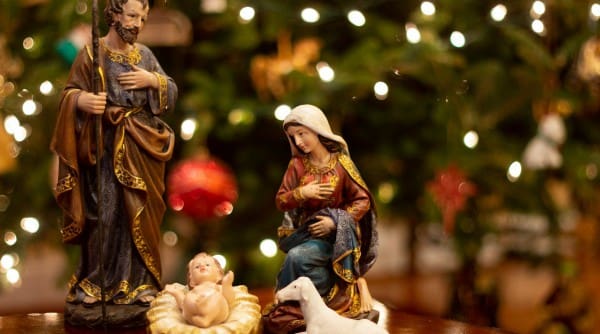Christmas is history: a little Child in a Crib. But it is also mystery: God with us.
The story of the Birth of Jesus was not the first part of the Gospel to be written down: It was recorded in light of the Death and Resurrection of Christ. You might say that the story of the Birth and Infancy of Jesus is written with Death and Resurrection ink. The story is colored by the early Christian experience of preaching the gospel — which, like Jesus Himself, was received by pagans but rejected by the Jews — and so these insights that emanated from the Death and Resurrection found their way into the story of the Birth and Infancy.
At His Death, Jesus was rejected by His own but acknowledged by the centurion on behalf of the pagan world. At His Birth, Jesus is rejected by Herod and Jerusalem but accepted by the Magi, also representing the pagan world. St. Matthew and St. Luke give not merely a chronicle of cold facts but also an interpretation — their own theological reflections on the events. As a result, the story of the Nativity provides a vantage point for reading the whole story of Jesus Christ. We are given a special insight that provides us with more information than even those who interacted with Jesus during His ministry.
The events surrounding the Birth of Jesus point us to the past and the future. On the one hand, they look to the past, where we see the hopes and longings of the Old Testament fulfilled. At the same time, the Nativity narrative looks to the future, heralding what will take place in Jesus’ public ministry. For example, at His Birth, Jesus was wrapped in swaddling clothes and laid in a manger. At His Death, He was wrapped in a burial cloth and laidin a rock-hewn tomb by Joseph of Arimathea.
The manger and the swaddling clothes also, of course, demonstrate the poverty into which Jesus was born. But St. Luke insists that in this sign of powerlessness, people will recognize the Savior of the world: “And this will be a sign for you: you will find a babe wrapped in swaddling cloths and lying in a manger” (Luke 2:12). This may be an illusion to King Solomon, son of David, who claimed to be the royal child since he, like all kings, had been wrapped in swaddling cloths. Every time a descendant of David ascended the throne, it was hoped that this king would prove to be the ideal king, the Messiah. St. Luke is therefore presenting Jesus as Son of God and true king.
The church that sits at the traditional location of Christ’s Birth has a very unusual feature: The door of entry is very low, so low that one has to stoop in order to enter. When we think of Christmas and the Incarnation, we are really reflecting on the feast of the stooping down of God, His condescension. Our planet is but a tiny speck among the stars of the universe, and the Hand that spun the stars shivered in the cold of earth in Bethlehem. That was the beginning of the stooping down of God, and it continued until the day He allowed Himself to be nailed to a Cross — and it continues to this day in the form of the Eucharist.
When He arrived in Bethlehem, He did so very gently. Everything in Bethlehem suggests gentleness. Mary and Joseph accepted gently being turned away at the inn. The shepherds listened to the message of the angels and gently made their way to Bethlehem to find the Child and His Mother. The Magi gently received the answer of the jealous Herod and continued their journey from Jerusalem to Bethlehem until they found the manger. There would be so much more peace in our lives if we knew how to be truly gentle with ourselves and with others. When the Infant of Bethlehem grew to manhood, He asked His followers to learn from Him so that they would be gentle and humble of heart.
An infant is the least threatening of all humans. A newborn is helpless, his simple and straightforward language — that is, his cry — is that of dependence and humility. The language of God at Christmas is the language of love, the language of humility and simplicity. Our call, as followers of Jesus Christ, is to learn that language, not only at Christmas, but throughout the year. The season brings to the surface social attitudes that may be less apparent at other time. We become more aware of the polarization in our culture as Christmas brings out the opposites: generosity and greed, gentleness and violence, kindness and coarseness, patience and bullying.
–Archbishop Michael Neary, 2004
+
This article is adapted from a chapter in Advent Reflections, edited by Brandon McGinley, which is available from Sophia Institute Press.

Art for this post on the Christmas: Cover and featured image used with permission.




